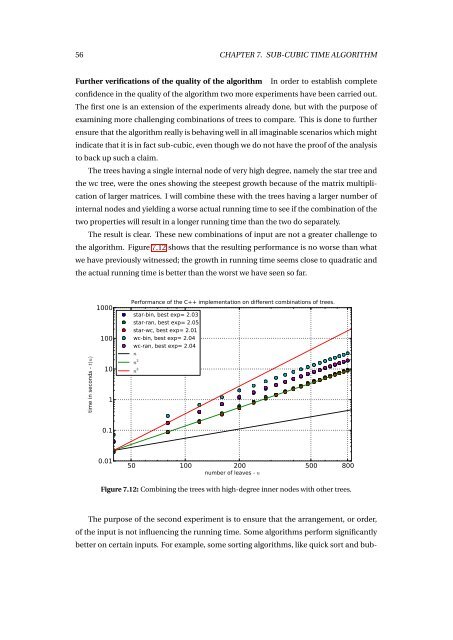computing the quartet distance between general trees
computing the quartet distance between general trees
computing the quartet distance between general trees
Create successful ePaper yourself
Turn your PDF publications into a flip-book with our unique Google optimized e-Paper software.
56 CHAPTER 7. SUB-CUBIC TIME ALGORITHMFur<strong>the</strong>r verifications of <strong>the</strong> quality of <strong>the</strong> algorithm In order to establish completeconfidence in <strong>the</strong> quality of <strong>the</strong> algorithm two more experiments have been carried out.The first one is an extension of <strong>the</strong> experiments already done, but with <strong>the</strong> purpose ofexamining more challenging combinations of <strong>trees</strong> to compare. This is done to fur<strong>the</strong>rensure that <strong>the</strong> algorithm really is behaving well in all imaginable scenarios which mightindicate that it is in fact sub-cubic, even though we do not have <strong>the</strong> proof of <strong>the</strong> analysisto back up such a claim.The <strong>trees</strong> having a single internal node of very high degree, namely <strong>the</strong> star tree and<strong>the</strong> wc tree, were <strong>the</strong> ones showing <strong>the</strong> steepest growth because of <strong>the</strong> matrix multiplicationof larger matrices. I will combine <strong>the</strong>se with <strong>the</strong> <strong>trees</strong> having a larger number ofinternal nodes and yielding a worse actual running time to see if <strong>the</strong> combination of <strong>the</strong>two properties will result in a longer running time than <strong>the</strong> two do separately.The result is clear. These new combinations of input are not a greater challenge to<strong>the</strong> algorithm. Figure 7.12 shows that <strong>the</strong> resulting performance is no worse than whatwe have previously witnessed; <strong>the</strong> growth in running time seems close to quadratic and<strong>the</strong> actual running time is better than <strong>the</strong> worst we have seen so far.time in seconds - t(n)1000100101Performance of <strong>the</strong> C++ implementation on different combinations of <strong>trees</strong>.star-bin, best exp= 2.03star-ran, best exp= 2.05star-wc, best exp= 2.01wc-bin, best exp= 2.04wc-ran, best exp= 2.04nn 2n 30.10.0150 100 200 500 800number of leaves - nFigure 7.12: Combining <strong>the</strong> <strong>trees</strong> with high-degree inner nodes with o<strong>the</strong>r <strong>trees</strong>.The purpose of <strong>the</strong> second experiment is to ensure that <strong>the</strong> arrangement, or order,of <strong>the</strong> input is not influencing <strong>the</strong> running time. Some algorithms perform significantlybetter on certain inputs. For example, some sorting algorithms, like quick sort and bub-
















